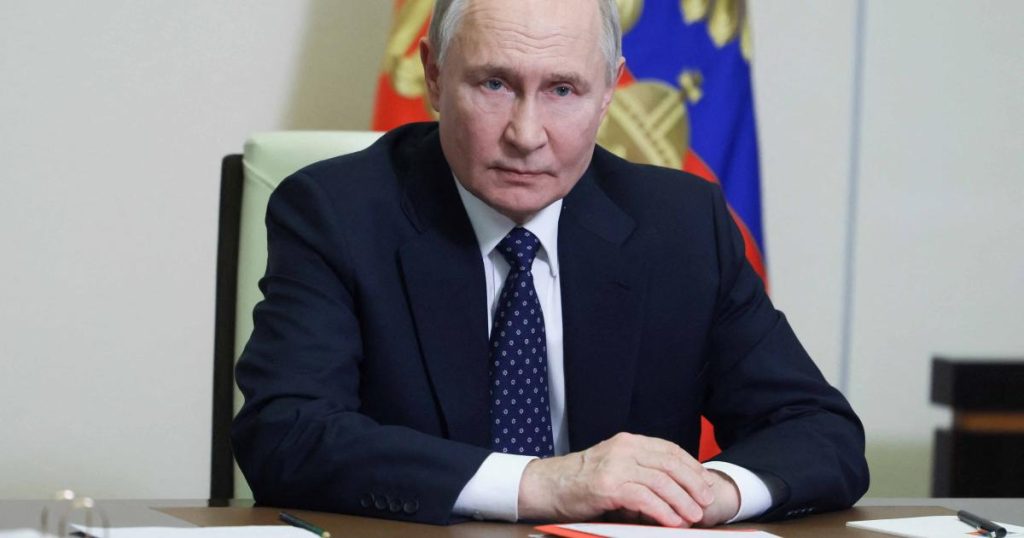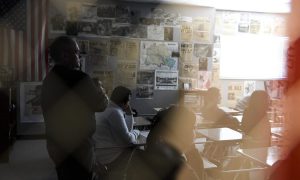
When talking about U.S. President Donald Trump and his turn against Kyiv, Russian President Vladimir Putin has tried to avoid public displays of triumph. After his first acknowledged conversation with Trump following the U.S. president’s return to the White House, on February 12, Putin has said that the initial goal of U.S.-Russian talks is simply to increase trust between the parties. When they talked again, for two hours on March 18, the Kremlin’s official statement indicated that “the leaders confirmed their intention to continue efforts aimed at reaching a settlement in Ukraine bilaterally.”
But Moscow’s gloating is hard to miss. “The U.S. is taking a much more balanced position,” said the Kremlin spokesperson Dmitry Peskov in February, two weeks after the first call. “We certainly welcome this.” In a press release after the second call, the Kremlin “expressed gratitude to Donald Trump for his desire to help achieve the noble goal of ending hostilities.” It would be shocking if they weren’t grateful: in less than two months, Trump has presented Russia with greater symbolic and material victories than the country could have fathomed. After Trump, U.S. Vice President JD Vance, and Ukrainian President Volodymyr Zelensky fought in the Oval Office on February 28, Trump temporarily suspended U.S. military assistance to Kyiv. Washington withdrew from a group dedicated to investigating war crimes by Russia’s leaders. It voted against a UN resolution that blamed Moscow for the war. And Trump and his senior officials repeatedly parroted Russian disinformation about the conflict, including by blaming it on Kyiv.
Russia’s leadership is aware that Trump’s warmth may not last forever. The president is emotionally volatile and has a short attention span. The experience of his first term, when the Kremlin’s hopes for a major improvement in U.S.-Russian ties were dashed after Congress imposed new sanctions on Russia and the White House delivered lethal weapons to Ukraine, serves as a cautionary tale. At a minimum, it is unlikely that the administration will unquestioningly accept all the Kremlin’s maximalist demands.
But Moscow is preparing to milk Trump for as much and as long as it can. The Kremlin hopes it can secure a one-on-one meeting between Putin and Trump in which they hammer out a deal that stops the war in Ukraine for now—exactly what Trump wants—in exchange for provisions that leave Ukraine permanently weakened. Putin favors an agreement that would place all kinds of restrictions on Kyiv and give Moscow a permanent voice in Ukrainian politics. But he would probably settle for one that limited Western support for the Ukrainian armed forces. Such a cutoff, the Kremlin figures, would be enough to ensure Moscow eventually defeated Kyiv. Putin would be happy even if the deal was rejected by the Ukrainians and their European allies. Trump would then have a reason to permanently end U.S. support for Kyiv.
Even if Putin cannot talk Trump into abandoning Ukraine, he still hopes to permanently repair other elements of U.S.-Russian relations, in part to lessen sanctions. But should that effort also fail, Russia’s leader will simply carry on as he has been. The Russian economy is struggling, but it is stable. Moscow has a massive manpower advantage over Kyiv. Putin hopes Washington will tacitly help him defeat Ukraine. But he is ready to fight on even if it doesn’t.
GREATEST ASSET
The Kremlin tried to start communicating with Trump almost as soon as he won the 2024 presidential election. It reached out to the then president-elect through formal Russian and U.S. intelligence channels. But it also reactivated links to various figures in Trump’s orbit. Most notably, Kirill Dmitriev, the CEO of the Russian Direct Investment Fund, used his ties to Trump’s son-in-law, Jared Kushner, and other members of the president’s family to reach Steve Witkoff—Trump’s special envoy for the Middle East. (Witkoff is now also overseeing diplomacy with Moscow.) This connection led to a prisoner exchange and, on February 18, a high-profile meeting in Riyadh, where Dmitriev and Witkoff were joined by Secretary of State Marco Rubio, National Security Adviser Mike Waltz, Russian Foreign Minister Sergey Lavrov, and Kremlin foreign policy aide Yuri Ushakov. The parties agreed to work toward ending the war and bettering bilateral relations.
Critically, this outreach also led to the two conversations between Trump and Putin himself. These talks appeared to have greatly shaped the U.S. president’s thinking. Trump was never a fan of Zelensky, but after the February 12 call with Putin, Trump began echoing Russian talking points, calling Zelensky a “dictator” and fretting about corruption in Ukraine. Putin, meanwhile, has parroted the Trump campaign’s narrative that if the 2020 U.S. election had not been “stolen,” Moscow would not have had any reason to go to war with Kyiv. The Russian leader, a former KGB recruiting officer, appears to have figured out how to manipulate Trump’s ego so that he adopts the Kremlin’s perspective.
Putin’s machinations go beyond just playing to Trump’s own predilections. Moscow has also won over the White House by positioning itself as a great power willing to advance Trump’s global agenda. Russia has expressed readiness to help the United States broker a deal with Iran. It has embraced Trump’s idea of slashing each country’s military budgets in half, and it has hinted that it can help bring China into that conversation. Rubio and Vance have even spoken of an opportunity to implement what some analysts call a “reverse Nixon” strategy by driving a wedge between Beijing and Moscow—just as U.S. President Richard Nixon did 50 years earlier, then to isolate the Kremlin. Such an effort would be utterly futile: the Kremlin won’t rock the boat with its most important geopolitical and economic partner, especially when the next U.S. president might do another U-turn in Washington’s Russia policy. But Moscow has won over Rubio, Vance, and Trump by quietly suggesting it might move out of China’s embrace if Washington gives Moscow some breathing space, such as by easing sanctions.
Putin appears to have figured out how to manipulate Trump’s ego.
The Kremlin has offered Trump a variety of other reasons to warm relations. It has appealed to the two countries’ shared history as World War II allies, something that Trump has celebrated. It has highlighted Putin and Trump’s joint antipathy toward progressive causes such as LGBTQ rights and their shared commitment to supposedly traditional values. It has referenced their mutual frustration with mainstream elites in Europe and North America. Finally, Moscow has suggested that the two countries could reach multiple business deals once they move beyond the current confrontation. In Riyadh, Dmitriev showed a slide deck alleging, falsely, that U.S. companies have lost $300 billion due to the war in Ukraine and sanctions on Russia. Left unstated, at least publicly, is that Trump’s relatives and friends might benefit from a resumption of commerce—especially given that Dmitriev knows them and their business partners in Saudi Arabia.
Against this backdrop, the Kremlin has made the war in Ukraine look like an unpleasant obstacle to a glorious partnership. It has played into Trump’s frustration with Kyiv’s insistence that any cessation of hostilities be accompanied by strong security guarantees against future Russian invasions, encouraging him to see Zelensky as the primary stumbling block to talks. Putin has also falsely claimed that Zelensky lacks a democratic mandate and that Ukraine must hold elections before inking any agreement—another talking point eagerly embraced by Trump.
Zelensky is a reluctant participant in peace negotiations, given the existential nature of the war and his deep distrust of the Kremlin. But Putin’s stances justify Zelensky’s reticence. Although he has depicted himself as flexible, Putin has instructed various Russian officials to take a maximalist position in negotiations by adhering to his demands from last June, which include the transfer of all the territory that Russia claims to Moscow’s control, U.S. recognition of these regions as part of Russia, neutrality for Ukraine, a mandatory reduction in the size of Ukraine’s military, the cancellation of any security agreements with Western countries, and special rights for Russian-speakers and the Russian Orthodox Church in Ukraine—which would give Moscow substantial power over Ukrainian domestic politics.
The Kremlin knows that Trump may not embrace all these conditions right now, but since Washington is already moving in Moscow’s direction, Russia’s leadership hopes Trump will get there. The odds will increase if Putin can secure a one-on-one summit with Trump, away from any pesky, pro-Ukrainian intermediaries. Following a summit with Putin in 2018, after all, Trump declared that he trusted the Russian leader more than the U.S. intelligence community. And the Kremlin believes that should Trump agree to Putin’s terms at such an event, no one will be able to stop him. Trump has decimated the bureaucracy, and the U.S. Congress is now controlled by his loyalists.
SITTING PRETTY
Trump, of course, plays his cards close to his chest, and he frequently changes his opinion. He also may not share Putin’s ultimate goal: stripping Ukraine of its sovereignty and perhaps eliminating it as a nation altogether, although Trump did once muse that Ukraine could become Russian one day. For now, all Trump clearly wants is an immediate cessation of hostilities, something Russia cares little about in and of itself.
But the Kremlin does believe it can leverage Trump’s desire for a cease-fire to make a deal that is pro-Russian, which means a deal that ends Ukraine’s security and military partnerships with the West. In a dream scenario for the Kremlin, this agreement would ensure that NATO states pledge to stop supplying weapons and intelligence to Kyiv. The Kremlin understands that Western partnerships are what helped Ukraine upgrade its defense capabilities and continue to allow it to stave off the Russian war machine. These partnerships are perhaps the primary threat to Putin’s expansionist ambitions. As a result, Putin would probably agree to a cease-fire if Trump agreed to this condition. In his remarks on March 13 about a prospective deal, Putin front-loaded this condition—as well as his demand that Ukraine stop mobilizing its armed forces. If these conditions were accepted by the United States and imposed on Ukraine, Moscow could use the cease-fire as an opportunity to rearm and—if it so chose—restart the war against a more vulnerable Kyiv once Trump was out of the way.
Trump may agree to such terms and then fail to deliver. The White House cannot force European countries to stop their own military cooperation with the Ukrainians. But the Kremlin is optimistic that he can persuade them. If Trump pressured the continent to stop backing Kyiv, Russia hopes, many governments might acquiesce rather than risk their own security partnership with Washington. And even if those countries (and Ukraine) refused, Trump might blame them for blocking his much-desired cease-fire. He could then permanently cut off U.S. aid from Ukraine—which, by itself, would do wonders for the Kremlin. Ukraine has become less dependent on external support over time, thanks to better indigenous manufacturing capacity. But the country still relies heavily on outside military aid, and the United States is responsible for the majority of it.
Should Trump refuse to end American support for Ukraine, Putin still believes that diplomacy could yield dividends. There is a reason why he has instructed Lavrov and Ushakov to prioritize normalizing U.S.-Russian diplomatic ties—including reinstating a full staff to its skeletal diplomatic missions—regardless of what happens with the talks over Ukraine. Putin’s other goal is some form of sanctions relief, which could help Russia’s middling economy. The Kremlin is already trying to woo American businesses to return and invest. Most wouldn’t do so even if sanctions were lifted, because the Russian legal regime disadvantages Western businesses and firms fear Trump’s successor could quickly restore restrictions. But some companies might go back.
DEAL OR NO DEAL
The Kremlin hopes that something good will come from Putin’s talks with Trump. But should everything go astray, Russia’s leadership believes it is still well positioned. It was prepared to keep fighting before Trump won, and it remains so today. It has a large manpower advantage over Kyiv—one that appears to be increasing. The Russian government’s lavish sign-up bonuses have led to a recruitment boom, as men (believing the conflict is nearing its end) rush to cash in. Russia is also ready to carry out another partial mobilization. Throughout the last 12 months, Moscow has worked with major employers to come up with lists of workers who have relevant military experience, making them easier to conscript. It has also made lists of workers who are indispensable to keeping the economy afloat and should therefore be spared.
The Russian economy will certainly face headwinds if the war continues and the country remains sanctioned. But Russia’s central bank and Finance Ministry are governed by competent technocrats, and they can prevent disaster. In the first two months of 2025, Russia’s budget spending hit a record $96 billion, thanks to payments for military production. This has prevented an economic depression, and the central bank’s 21 percent interest rates have prevented hyperinflation. The central bank projects that absent any political push to shift even more resources to the war, the economy will experience a soft landing. Growth will cool, but gradually, and the slowdown will tame inflation. Moscow will be able to avoid any major fiscal cliffs and disruptions.
None of this means Russia is guaranteed to triumph over Ukraine. Wars are unpredictable, and if the past three years offer any lesson, it is that military cooperation between Ukraine and NATO countries is stronger than anyone would have imagined before February 22. If Europe keeps helping Ukraine and if Kyiv can address its manpower shortages, Russia’s offensive could stall. Faced with mounting human losses, dwindling stores of equipment, and economic stagnation, Putin might decide that it is time to cement his gains, lest the tide change. He might then agree to a cease-fire along the current lines of control that does not limit Kyiv’s military cooperation with the West or its ability to rearm. Ukraine would not get all its territory back, but it would remain a truly sovereign and independent state, with control over its future and the capacity to deter future aggression.
Yet the West has not faced a challenge like Trump since the war began. Without the support of the United States, it will struggle to remain coordinated, focused, and disciplined in helping Kyiv. Almost as soon as the war commenced, it seemed as if Russia was destined to be at least partially defeated, with any settlement disappointing the Russians. But not anymore. For Moscow, bright days may well be ahead—or so think the men in the Kremlin.
Loading…








